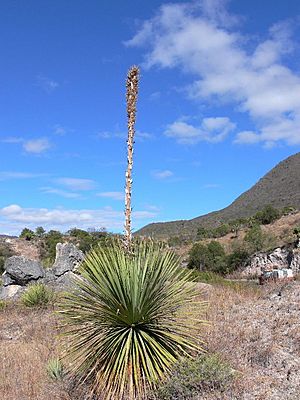Sandpaper sotol facts for kids
Quick facts for kids Sandpaper sotol |
|
|---|---|
 |
|
| Scientific classification | |
| Synonyms | |
|
Dasylirion serratifolium, also known as the sandpaper sotol, is a unique plant. It belongs to the Asparagaceae family, which also includes asparagus! This plant is originally from Mexico, specifically from the states of Hidalgo and Oaxaca. People often grow it in other places, even in Europe, because it looks so interesting.
Contents
About the Sandpaper Sotol
The sandpaper sotol gets its name from its leaves. They feel rough, a bit like sandpaper! This plant is a type of sotol, which are desert plants known for their tough, sword-like leaves. They are very good at living in dry, sunny places.
What the Sandpaper Sotol Looks Like
The sandpaper sotol grows a short, thick trunk over many years. This trunk can be up to 5 feet (1.5 meters) tall. At the top of the trunk, there's a big, round cluster of leaves.
Its Unique Leaves
The leaves are long and narrow, like straps. They can grow up to 3 feet (90 cm) long and are a pretty blue-green color. Along the edges of each leaf, there are small, sharp teeth. These teeth, along with the rough surface, give the plant its "sandpaper" feel. The leaves grow in a spiral pattern, making a neat, round shape.
Flowers and Stalks
When the plant is old enough, it sends up a tall flower stalk from the center of its leaves. This stalk can be very tall, sometimes reaching 10 to 15 feet (3 to 4.5 meters) high! Small, bell-shaped flowers grow all along this stalk. These flowers can be creamy white or yellowish. After the flowers bloom, they produce small, dry fruits that contain the seeds.
Where the Sandpaper Sotol Grows
This plant is native to the dry, rocky areas of central and southern Mexico. It thrives in places with lots of sun and not much water. You can find it growing on hillsides and in open woodlands. The states of Hidalgo and Oaxaca have the perfect climate for this tough plant.
Adapting to Dry Places
Sotols are well-adapted to desert and semi-desert environments. Their thick leaves help them store water. The rough texture and sharp edges of the leaves might also help protect them from animals that want to eat them. They are very resilient plants that can handle tough conditions.
How It Reproduces
The sandpaper sotol reproduces by making seeds. When the tall flower stalk appears, it means the plant is ready to make new plants.
The Life Cycle
- Flowering: The plant produces a tall stalk with many small flowers. These flowers are pollinated by insects or wind.
- Seed Production: After pollination, the flowers turn into small fruits. Each fruit holds several seeds.
- Seed Dispersal: When the seeds are ready, they fall to the ground or are carried by wind or animals.
- New Plants: If the seeds land in a good spot with enough moisture, they can sprout and grow into new sandpaper sotol plants. It takes many years for a young plant to grow large enough to produce its own flower stalk.
Uses of Sotol Plants
Sotol plants, including the sandpaper sotol, have been used by people for hundreds of years.
Traditional Uses
- Food and Drink: In Mexico, the heart of some sotol plants is roasted and eaten. It tastes sweet. The plant is also used to make an alcoholic drink called "sotol," similar to tequila or mezcal.
- Crafts: The long, tough leaves can be used to weave baskets, mats, and other useful items.
- Building Materials: The dried flower stalks are strong and light. They can be used for building small structures or fences.
Ornamental Plant
Today, the sandpaper sotol is also very popular as an ornamental plant. This means people grow it in gardens and parks because it looks beautiful and unique. It's a great choice for xeriscaping, which is a type of landscaping that uses plants that need very little water. Its striking appearance makes it a favorite in desert gardens around the world.
See also
 In Spanish: Dasylirion serratifolium para niños
In Spanish: Dasylirion serratifolium para niños

